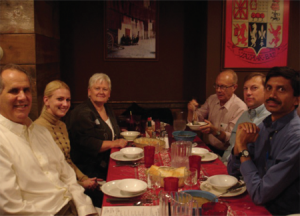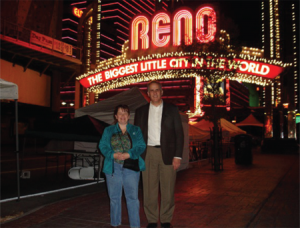A Few Chapters in My Presidency

ASA President Nathaniel Schenker (back row, far right) with members of the Florida Chapter during the chapter’s 2014 annual meeting at the University of Florida, Gainesville
(Photograph by Renee Parks-James)
One of my favorite activities as ASA president has been visiting ASA chapters. During these visits, I’ve spoken about ASA initiatives and other topics in statistics, participated in chapter activities, met members, and found out what’s happening in the ASA at the local level.
The ASA has 72 chapters across the United States and Canada, with a total of nearly 9,000 members. The broad objective of the chapters is to promote statistics and its applications. Chapters are designed to increase the unity and effectiveness of individuals within local geographical areas. They engage in many activities, such as holding meetings, producing publications, participating in educational efforts, providing information about the application of statistics, and making statistics of service to society while making society aware of statistics as a science.

Following the Nevada Chapter’s 2013 Fall Symposium at the University of Nevada, Reno, ASA President Nathaniel Schenker dines with members of the chapter.
(Photograph by Alicia Hansen)
The ASA and Council of Chapters (COC) offer many resources (see ASA community resources page) to chapters, including the Chapter Visitation Program. Since last fall, I’ve visited the Nevada, Southern California, and Florida chapters, and I’ll visit the Connecticut Chapter at the end of the summer. In addition, several other chapters have been or will soon be visited by the ASA executive director, members of the ASA board, or members of the COC Governing Board.
My speaking engagements have varied across the chapters. In Nevada and Southern California, I gave two talks each: one on the ASA’s 175th anniversary and this year’s initiatives and one on a topic in statistical methodology and applications. In contrast, I gave a banquet speech in Florida in which I tried to be “inspirational” and discuss the value of service to the profession; that is what I have planned for Connecticut, as well.
What Have I Learned from My Visits?
Geography: Some of the chapters cover entire states, such as Connecticut and Nevada, whereas others cover sub-areas of their states, such as the Florida Chapter, which covers the northern part of the state, and the Southern California Chapter, which covers Southern California outside of Long Beach, San Diego, and Orange County.

ASA President Nathaniel Schenker is given a tour of Reno by then chapter president Alicia Hansen.
(Photograph by Michael Hansen)
Membership: The composition of chapter membership varies quite a bit. The sizes range from fewer than 50 members in the Nevada Chapter to hundreds of members in the Southern California Chapter. In addition, some chapters have large contingents from one sector, such as the Florida Chapter, whose majority is professors and students, and the Connecticut Chapter, with nearly 50% of its members from the pharmaceutical industry.
Activities: The chapters conduct a wide variety of activities. Each has an annual meeting/conference. The largest I attended was the Florida Chapter’s annual meeting, which had about 13 hours of activities over two days, including paper and poster sessions, a student paper competition, and a dinner banquet. Examples of other activities include the Connecticut Chapter’s poster competition, annual banquet, and Honor a Statistician Award; the Nevada Chapter’s K–12 Statistics Poster Competition, chapter newsletter, periodic dinner speaker meetings, and fledgling mentoring program; and the Southern California Chapter’s Applied Statistical Workshop, R group, Career Day, and high school statistical abstract competition.
Opportunities: The chapters offer local activities that are much more accessible to some members than are national activities like JSM. They also provide excellent opportunities for their members—and notably for students, isolated statisticians, and those early in their careers—to give talks and meet others in their profession. I benefited from such chapter-based opportunities myself when I moved to Washington, DC, after graduate school to work at the U.S. Census Bureau and then again when I moved across the country to teach at the University of California, Los Angeles.
Challenges: The chapters have some challenges related mainly to geography and membership. Issues include difficulties due to membership spread over large, albeit subnational, geographical areas; diversifying membership so a variety of sectors and topics are well-represented; and recruiting members in general, especially those interested in helping with activities and taking leadership roles.
Some Advice for Chapters
Keep on trucking: I’ve been impressed by the energy, camaraderie, and opportunities provided by the chapters I’ve visited. Clearly, it’s a challenge to organize gatherings of people from large geographic areas, and there is “competition” from email, social networks, etc. But I continue to feel that, in many ways, there is no substitute for face-to-face get-togethers. So, keep doing what you’re doing and consider mechanisms that might facilitate get-togethers, such as local sub-meetings, videoconferencing, and the use of Meetup.

ASA President Nathaniel Schenker with members of the Southern California Chapter during the chapter’s 2013 Fall Kick-Off Meeting at the City of Hope, Duarte, California
(Photograph by Joe Jiang)
Help the ASA with its Big Tent efforts: The ASA strives to be The Big Tent for Statistics, meaning it should welcome and provide value to a wide variety of people whose work is related to statistics. Chapters can aid substantially in this effort by working to diversify their memberships (as some have already indicated a desire to do) and reaching out to underserved groups and people who work in emerging areas of practice, while continuing to serve their traditional constituencies.
Learn from each other: Based on my visits to a few chapters and conversations with members of other chapters, it is clear that many chapters have common desires and issues. So, there is an opportunity to help and learn from each other. Case in point: Mentoring has been a “hot” activity in the ASA, with new mentoring programs introduced at the Conference on Statistical Practice and JSM this year. As mentioned earlier, the Nevada Chapter has a fledgling mentoring program, which it is working to “get off the ground.” During visits to other chapters, I’ve received questions regarding what mentoring resources exist. Perhaps several chapters could work together to develop a chapter-level mentoring program and/or to share their experiences in this area.
Don’t be shy about asking for support: As mentioned earlier, the ASA and COC offer a variety of services to the chapters, such as the visitation program, short courses, and event planning. Chapters should feel free to take advantage of this support. In particular, don’t be shy about inviting ASA and COC officials to visit. Although it might have seemed like “seeking praise,” I asked the chapters I’ve visited or will visit how, if at all, it is helpful to them to have a presidential visit. Benefits mentioned in the responses included learning about ASA initiatives and other topics, increasing prestige and visibility, providing inspiration to students, encouraging members to take on leadership roles, and helping recruit new members.
Conclusion
Chapters play an important role in our association, and they have been helpful to me throughout my career, especially early on. I have felt impressed, inspired, and proud in my visits to chapters so far, and I look forward to visiting others in the future.

















